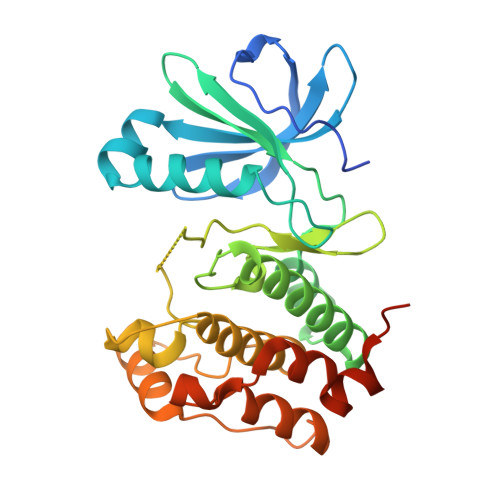Development of potent dual PDK1/AurA kinase inhibitors for cancer therapy: Lead-optimization, structural insights, and ADME-Tox profile.
Sestito, S., Bacci, A., Chiarugi, S., Runfola, M., Gado, F., Margheritis, E., Gul, S., Riveiro, M.E., Vazquez, R., Huguet, S., Manera, C., Rezai, K., Garau, G., Rapposelli, S.(2021) Eur J Med Chem 226: 113895-113895
- PubMed: 34624821
- DOI: https://doi.org/10.1016/j.ejmech.2021.113895
- Primary Citation of Related Structures:
7O2V - PubMed Abstract:
We report the synthesis of novel first-in-class 2-oxindole-based derivatives as dual PDK1-AurA kinase inhibitors as a novel strategy to treat Ewing sarcoma. The most potent compound 12 is suitable for progression to in vivo studies. The specific attributes of 12 included nanomolar inhibitory potency against both phosphoinositide-dependent kinase-1 (PDK1) and Aurora A (AurA) kinase, with acceptable in vitro ADME-Tox properties (cytotoxicity in 2 healthy and 14 hematological and solid cancer cell-lines; inhibition of PDE4C1, SIRT7, HDAC4, HDAC6, HDAC8, HDAC9, AurB, CYP1A2, CYP2C9, CYP2C19, CYP2D6, and hERG). X-ray crystallography and docking studies led to the identification of the key AurA and PDK1/12 interactions. Finally, in vitro drug-intake kinetics and in vivo PK appear to indicate that these compounds are attractive lead-structures for the design and synthesis of PDK1/AurA dual-target molecules to further investigate the in vivo efficacy against Ewing Sarcoma.
Organizational Affiliation:
Department of Pharmacy, University of Pisa, 56126, Pisa, Italy.















